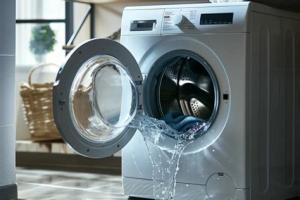Ultimate Guide to Troubleshooting & Repairing a Washer That Doesn’t Drain

-
Quick Links:
- Introduction
- Understanding the Issue
- Common Causes of Washer Drain Issues
- Step-by-Step Troubleshooting Guide
- Repairing the Problem
- Case Studies
- Expert Insights
- Prevention Tips
- FAQs
Introduction
Having a washer that doesn’t drain can be a frustrating experience, especially when you have a pile of dirty laundry waiting to be cleaned. This guide will provide you with comprehensive steps to troubleshoot and repair your washing machine efficiently, ensuring you save both time and money.
Understanding the Issue
A washing machine that doesn’t drain properly can lead to water accumulation within the drum, creating a breeding ground for mold and mildew. Understanding the mechanics of your washer is crucial for effective troubleshooting.
Common Causes of Washer Drain Issues
- Clogged Drain Hose: This is one of the most common issues.
- Faulty Pump: If the pump is broken, water will not be expelled.
- Blocked Filter: A dirty filter can prevent drainage.
- Electrical Problems: Issues with wiring can affect performance.
- Load Imbalance: An unbalanced load can affect the washer's ability to drain.
Step-by-Step Troubleshooting Guide
Follow these detailed steps to identify and resolve drainage problems in your washer.
Step 1: Check the Drain Hose
Inspect the drain hose for kinks or clogs. It should be elevated at the right height and not submerged in water.
Step 2: Clean the Filter
Most washers have a filter that can get clogged. Locate it, remove any debris, and clean it thoroughly.
Step 3: Examine the Pump
Listen for unusual noises from the pump. If it’s silent or making strange sounds, it may need replacement.
Step 4: Check Electrical Connections
Inspect the wiring and connections to ensure everything is intact and functioning.
Step 5: Test the Washer
After making adjustments, run a test cycle to see if the issue is resolved.
Repairing the Problem
Once you’ve identified the issue through troubleshooting, follow these repair tips:
Replacing the Drain Pump
If the pump is faulty, replacing it is a straightforward task. Ensure you have the correct model for your washer.
Clearing Clogs
For clogged hoses or filters, use a plumbing snake or a mixture of vinegar and baking soda to clear obstructions.
Case Studies
Let’s look at a few real-world examples of common washer drainage issues and their solutions:
Case Study 1: The Clogged Drain Hose
A homeowner discovered that their washer wouldn’t drain during the spin cycle. Upon inspection, they found the drain hose was kinked. After straightening it out, the washer drained perfectly.
Case Study 2: The Malfunctioning Pump
Another case involved a washer that made a grinding noise but wouldn’t drain. The pump was replaced, which resolved the issue.
Expert Insights
Experts suggest regular maintenance checks for your washing machine to avoid drainage issues. Cleaning the filter and drain hose every few months can prevent future problems.
Prevention Tips
- Regularly clean the filter and drain hose.
- Avoid overloading the washer.
- Use appropriate detergents to prevent buildup.
- Check for leaks and wear on hoses periodically.
FAQs
1. Why is my washer not draining?
Common reasons include clogged hoses, a faulty pump, or a blocked filter.
2. How can I tell if my drain pump is broken?
If you hear unusual noises or if water remains in the drum after a cycle, the pump may be malfunctioning.
3. Can I fix the washer myself?
Yes, many issues can be resolved with basic tools and some troubleshooting knowledge.
4. How often should I clean my washer’s filter?
It’s recommended to clean it every 1-3 months, depending on usage.
5. What should I do if the washer still won’t drain after troubleshooting?
If the problem persists, consulting a professional technician may be necessary.
6. Is it safe to run my washer if it won’t drain?
No, running a washer that won’t drain can lead to more significant water damage and mold growth.
7. What tools do I need to troubleshoot my washer?
A screwdriver, pliers, and a bucket are typically sufficient for most repairs.
8. How can I prevent washer drainage issues?
Regular maintenance, including cleaning filters and hoses, can help prevent drainage problems.
9. What if my washer is under warranty?
If under warranty, contact the manufacturer or retailer before attempting repairs yourself.
10. Are there any resources for further assistance?
Yes, sites like Appliance Blog and Consumer Reports offer additional guidance.
For further information and in-depth studies on washer maintenance and repair, consider visiting Ace Hardware or Home Depot.
Random Reads
- Clean rubber bath mat
- Check storage space flash drive
- How to remove glue from counter tops
- How to hook up comcast cable box
- How to install vshare
- How to install whatsapp
- Easiest way to get facebook app iphone
- How to refresh a webpage
- How to install iso game file windows pc
- How to get strength in pokemon emerald